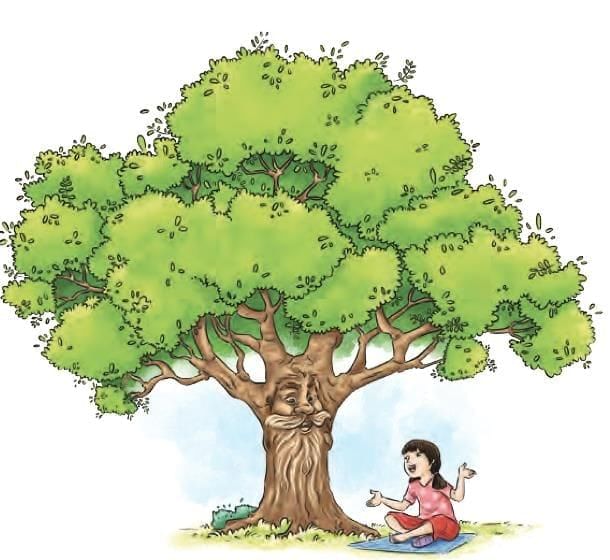Important Questions: Neem Baba | English for Class 6 PDF Download
Q1: What did Amber call the neem tree?
a) Tree Grandpa
b) Neem Baba
c) Magic Tree
d) Bitter Grace
Answer: b
Explanation: Amber called the neem tree Neem Baba because the tree said, “You may call me ‘Neem Baba.’
Q2: In which language is the neem tree called “Arishta”?
a) Hindi
b) Persian
c) Sanskrit
d) Tamil
Answer: c
Explanation: The neem tree is called Arishta in Sanskrit, as stated by Neem Baba.
Q3: What is one medicinal use of neem mentioned in the story?
a) Treating headaches
b) Curing measles
c) Healing broken bones
d) Preventing colds
Answer: b
Explanation: Neem leaves are used for curing measles because “Neem leaves…destroy germs…Measles cause itching…Neem leaves give comfort.”
Q4: How does neem help in farming?
a) By providing shade only
b) By repelling pests and preventing plant diseases
c) By increasing soil erosion
d) By attracting locusts
Answer: b
Explanation: Neem helps farming as “If the powder of neem seeds is mixed in water and sprayed on plants…locusts don’t eat them…stops mosquito breeding…saves the crop from termites.”
Q5: What is the meaning of the word “locusts”?
a) Healing plants
b) Insects that damage crops
c) Types of birds
d) Medicinal chemicals
Answer:b
Explanation: Locusts are “flying insects that damage crops.”
Q6: What material is neem wood resistant to?
a) Water
b) Fire
c) Termites
d) Rust
Answer: c
Explanation: Neem wood is resistant to termites: “Furniture made from neem wood is not eaten by termites.”
Q7: What product is neem used to make, as mentioned in the story?
a) Clothes
b) Soap
c) Paper
d) Glass
Answer: b
Explanation: Neem is used to make soaps and toothpaste: “Neem oil is also used to make soaps and toothpaste.”
Q8: Where did the neem tree first grow, according to Neem Baba?
a) South India or Sri Lanka
b) North India or Myanmar
c) Africa or Iran
d) China or Nepal
Answer: b
Explanation: Neem Baba said he was “born…somewhere in North India or Myanmar.”
Q9: Why is neem called the “bitter grace of God”?
a) Because it tastes sweet
b) Due to its many beneficial uses
c) Because it grows slowly
d) Due to its tall height
Answer: b
Explanation: Scientists call neem the “bitter grace of God” because “People find us useful and that is why they know us.”
Q10: What did Neem Baba encourage Amber to do?
a) Plant more trees
b) Keep learning about neem’s benefits
c) Move to another place
d) Stop talking to trees
Answer: b
Explanation: Neem Baba told Amber, “There are many qualities yet to be discovered. Will you discover them when you grow up?” showing she should keep learning about neem’s benefits.
Q11: Why did Amber feel a special connection with the neem tree?
Answer: Amber felt a special connection because she found peace under the neem tree, and it seemed to speak to her, reminding her of her childhood days playing in its shade.
Q12: Name two different names for the neem tree.
Answer: Two names for the neem tree are “Arishta” in Sanskrit and “Nim” in India.
Q13: How is neem used in everyday hygiene?
Answer: Neem is used in everyday hygiene by using its twigs to clean teeth and in making soaps and toothpaste.
Q14: What is one way neem benefits farming, as explained by Neem Baba?
Answer: Neem repels pests like locusts, protecting crops and preventing plant diseases in farming.
Q15: Define the word “medicinal” and give an example from the text.
Answer: Medicinal means relating to healing properties. An example is neem leaves curing measles due to their germ-killing chemicals.
Q16: Describe the medicinal uses of neem as explained by Neem Baba, with examples.
Answer: Neem Baba explained that neem has many medicinal uses due to chemicals in its leaves, bark, flowers, fruits, and roots that kill germs and heal diseases. For example, neem is used to treat measles, helping patients recover. It also cures respiratory problems, easing breathing difficulties, and relieves eye itchiness, as Amber recalled from her family’s use. These properties make neem a natural remedy for various ailments, earning it names like “Arishta” (one who cures diseases). Its ability to strengthen the immune system further highlights its importance in health, showcasing neem as a versatile medicinal plant.
Neem plant
Q17: Explain how neem is beneficial in farming and daily life, with examples.
Answer: Neem is highly beneficial in farming and daily life. In farming, neem-based solutions repel pests like locusts, protect crops, and prevent plant diseases, ensuring healthy harvests. It also controls mosquito breeding and preserves stored grains, supporting agricultural sustainability. In daily life, neem twigs are used to clean teeth, and neem is an ingredient in soaps and toothpaste for hygiene. Neem wood, being termite-resistant, is used for durable furniture, and neem purifies the air, improving environmental health. These multifaceted uses, as shared by Neem Baba, demonstrate neem’s practical value in enhancing both agriculture and everyday living.
Q18: Discuss the theme and message of the story, and how Amber’s conversation with Neem Baba reflects these ideas.
Answer: The theme of the story is the appreciation of nature’s gifts, particularly the neem tree’s multifaceted benefits in health, farming, and daily life. It emphasizes neem’s medicinal, agricultural, and practical uses, fostering respect for natural resources. The message is to value and protect nature’s contributions, using them wisely for human and environmental health. Amber’s conversation with Neem Baba reflects these ideas as she learns about neem’s names, medicinal properties (e.g., curing measles), and uses in farming (e.g., pest control) and products (e.g., soap). Her curiosity and Neem Baba’s blessings encourage her to continue exploring nature’s wonders, reinforcing the importance of learning and caring for trees like neem.
Q19: Why is it important to respect and protect trees like neem, and how can students contribute to this, inspired by Amber’s story?
Answer: Respecting and protecting trees like neem is important because they provide medicinal benefits (e.g., curing diseases), support farming (e.g., pest control), and enhance daily life (e.g., hygiene products), as Amber learned from Neem Baba. They also purify air and sustain ecosystems, benefiting human and environmental health. Inspired by Amber’s curiosity, students can contribute by planting neem trees, spreading awareness about their uses, and avoiding harm to trees. They can participate in school campaigns to promote tree conservation and use neem products, fostering a deeper appreciation for nature’s gifts and ensuring their preservation for future generations.
|
66 videos|528 docs|71 tests
|
FAQs on Important Questions: Neem Baba - English for Class 6
| 1. Neem Baba ke baare mein kya jankari hai? |  |
| 2. Neem Baba ka istemal kis prakar ki bimariyon ke ilaaj mein hota hai? |  |
| 3. Neem Baba ki kis tarah se pooja ki jaati hai? |  |
| 4. Neem Baba ka vaibhav paryavaran par kya prabhav daalta hai? |  |
| 5. Neem Baba ke vriksh ko kis prakar se lagana aur dekhbhal karna chahiye? |  |


















